Business Strategy Analysis for Klarna Bank AB: Report and Analysis
VerifiedAdded on 2023/01/12
|14
|4873
|87
Report
AI Summary
This report provides a comprehensive analysis of Klarna Bank AB's business strategy. It begins with an introduction to Klarna, a Swedish bank specializing in online financial services, and outlines its vision, mission, and objectives. The report then delves into the external environment using PESTLE analysis to assess political, economic, social, technological, legal, and environmental factors impacting Klarna. Stakeholder analysis is also conducted to identify key stakeholders and their influence. The internal environment is examined using VRIO analysis and the McKinsey 7S model to evaluate Klarna's resources, capabilities, and organizational design. The report concludes with recommendations on growth strategies, aiming to help Klarna gain a competitive advantage and adapt to changing market conditions. The report emphasizes the importance of strategic planning and the need for Klarna to address both internal and external factors to ensure long-term sustainability and success in the market.
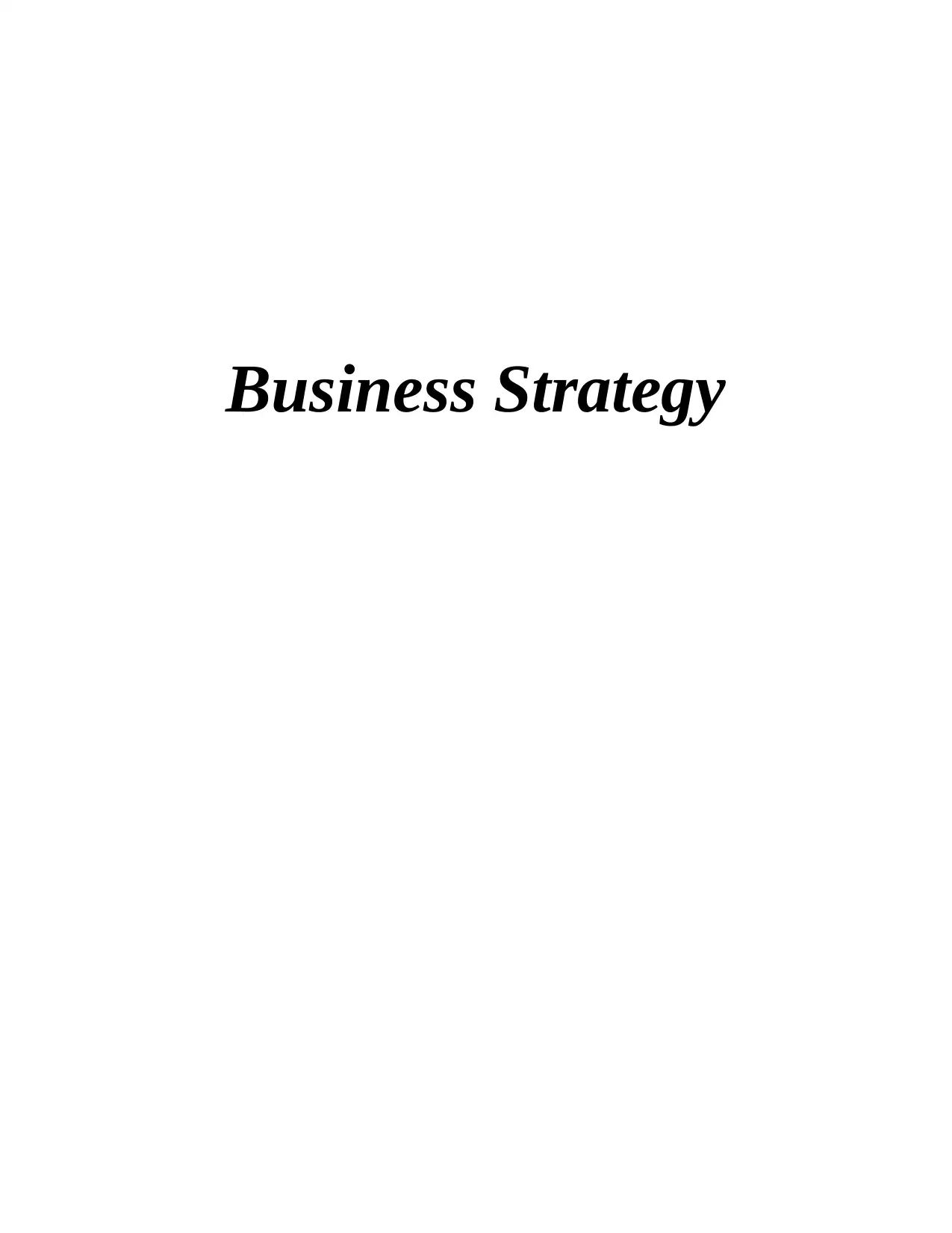
Business Strategy
Paraphrase This Document
Need a fresh take? Get an instant paraphrase of this document with our AI Paraphraser
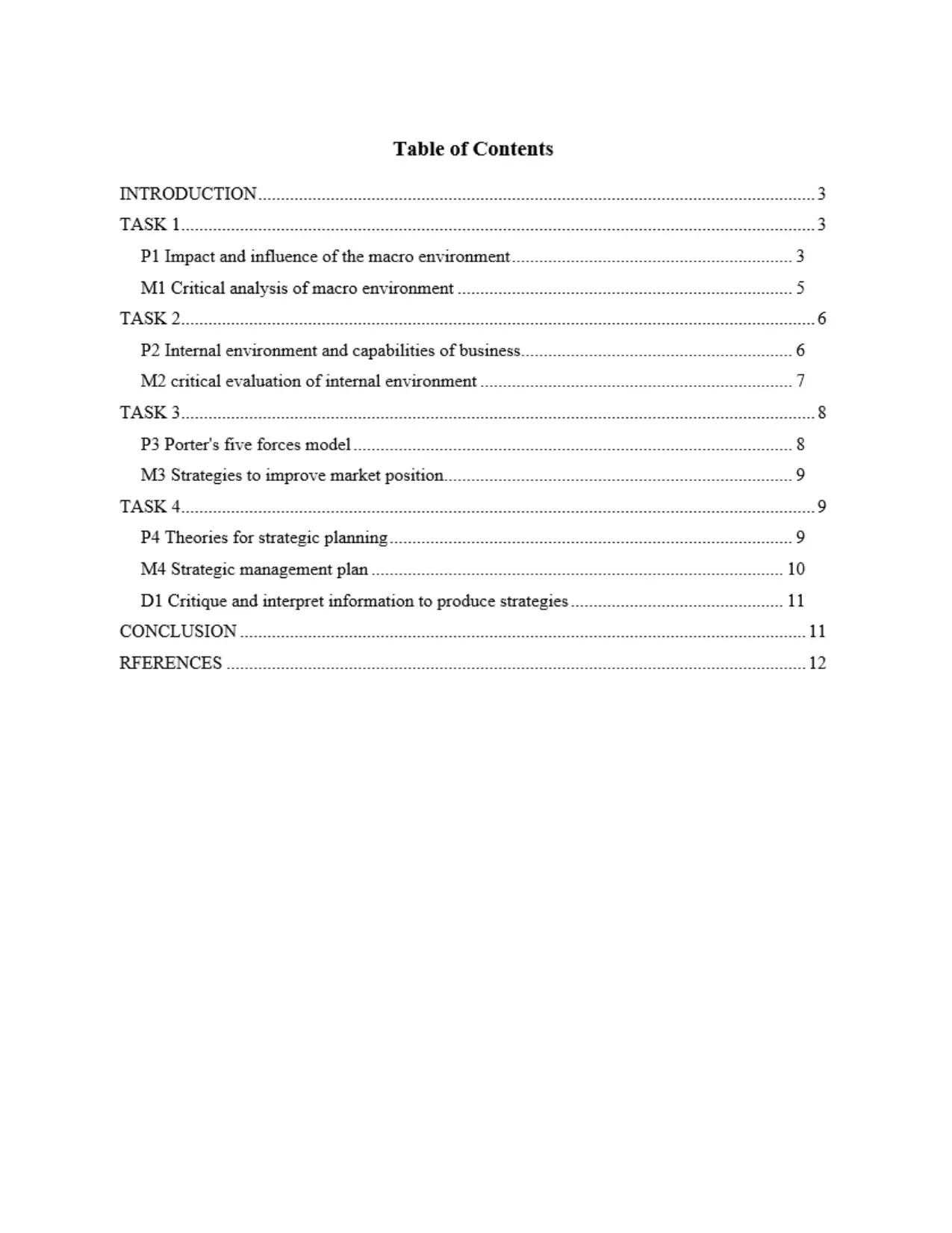
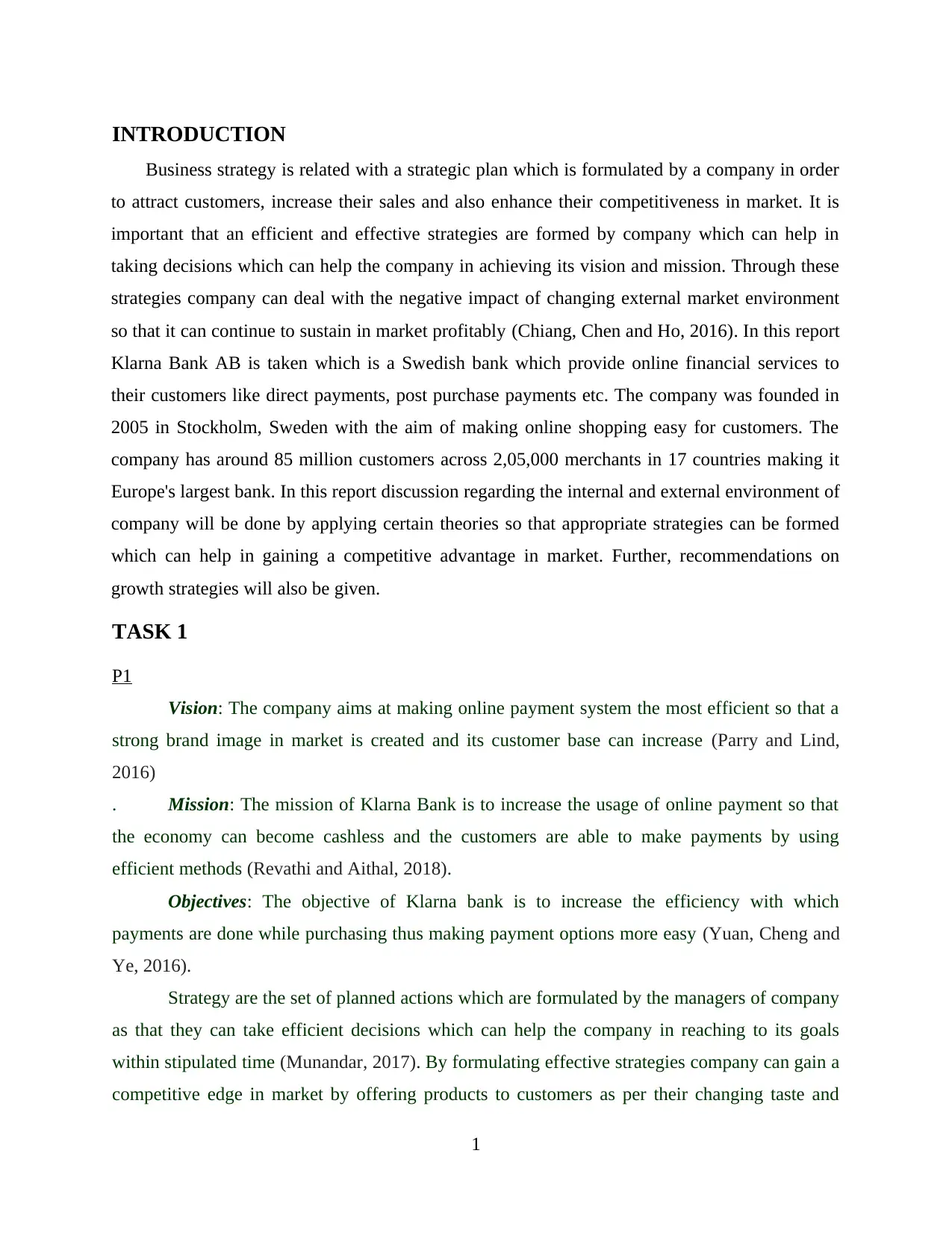
INTRODUCTION
Business strategy is related with a strategic plan which is formulated by a company in order
to attract customers, increase their sales and also enhance their competitiveness in market. It is
important that an efficient and effective strategies are formed by company which can help in
taking decisions which can help the company in achieving its vision and mission. Through these
strategies company can deal with the negative impact of changing external market environment
so that it can continue to sustain in market profitably (Chiang, Chen and Ho, 2016). In this report
Klarna Bank AB is taken which is a Swedish bank which provide online financial services to
their customers like direct payments, post purchase payments etc. The company was founded in
2005 in Stockholm, Sweden with the aim of making online shopping easy for customers. The
company has around 85 million customers across 2,05,000 merchants in 17 countries making it
Europe's largest bank. In this report discussion regarding the internal and external environment of
company will be done by applying certain theories so that appropriate strategies can be formed
which can help in gaining a competitive advantage in market. Further, recommendations on
growth strategies will also be given.
TASK 1
P1
Vision: The company aims at making online payment system the most efficient so that a
strong brand image in market is created and its customer base can increase (Parry and Lind,
2016)
. Mission: The mission of Klarna Bank is to increase the usage of online payment so that
the economy can become cashless and the customers are able to make payments by using
efficient methods (Revathi and Aithal, 2018).
Objectives: The objective of Klarna bank is to increase the efficiency with which
payments are done while purchasing thus making payment options more easy (Yuan, Cheng and
Ye, 2016).
Strategy are the set of planned actions which are formulated by the managers of company
as that they can take efficient decisions which can help the company in reaching to its goals
within stipulated time (Munandar, 2017). By formulating effective strategies company can gain a
competitive edge in market by offering products to customers as per their changing taste and
1
Business strategy is related with a strategic plan which is formulated by a company in order
to attract customers, increase their sales and also enhance their competitiveness in market. It is
important that an efficient and effective strategies are formed by company which can help in
taking decisions which can help the company in achieving its vision and mission. Through these
strategies company can deal with the negative impact of changing external market environment
so that it can continue to sustain in market profitably (Chiang, Chen and Ho, 2016). In this report
Klarna Bank AB is taken which is a Swedish bank which provide online financial services to
their customers like direct payments, post purchase payments etc. The company was founded in
2005 in Stockholm, Sweden with the aim of making online shopping easy for customers. The
company has around 85 million customers across 2,05,000 merchants in 17 countries making it
Europe's largest bank. In this report discussion regarding the internal and external environment of
company will be done by applying certain theories so that appropriate strategies can be formed
which can help in gaining a competitive advantage in market. Further, recommendations on
growth strategies will also be given.
TASK 1
P1
Vision: The company aims at making online payment system the most efficient so that a
strong brand image in market is created and its customer base can increase (Parry and Lind,
2016)
. Mission: The mission of Klarna Bank is to increase the usage of online payment so that
the economy can become cashless and the customers are able to make payments by using
efficient methods (Revathi and Aithal, 2018).
Objectives: The objective of Klarna bank is to increase the efficiency with which
payments are done while purchasing thus making payment options more easy (Yuan, Cheng and
Ye, 2016).
Strategy are the set of planned actions which are formulated by the managers of company
as that they can take efficient decisions which can help the company in reaching to its goals
within stipulated time (Munandar, 2017). By formulating effective strategies company can gain a
competitive edge in market by offering products to customers as per their changing taste and
1
⊘ This is a preview!⊘
Do you want full access?
Subscribe today to unlock all pages.

Trusted by 1+ million students worldwide
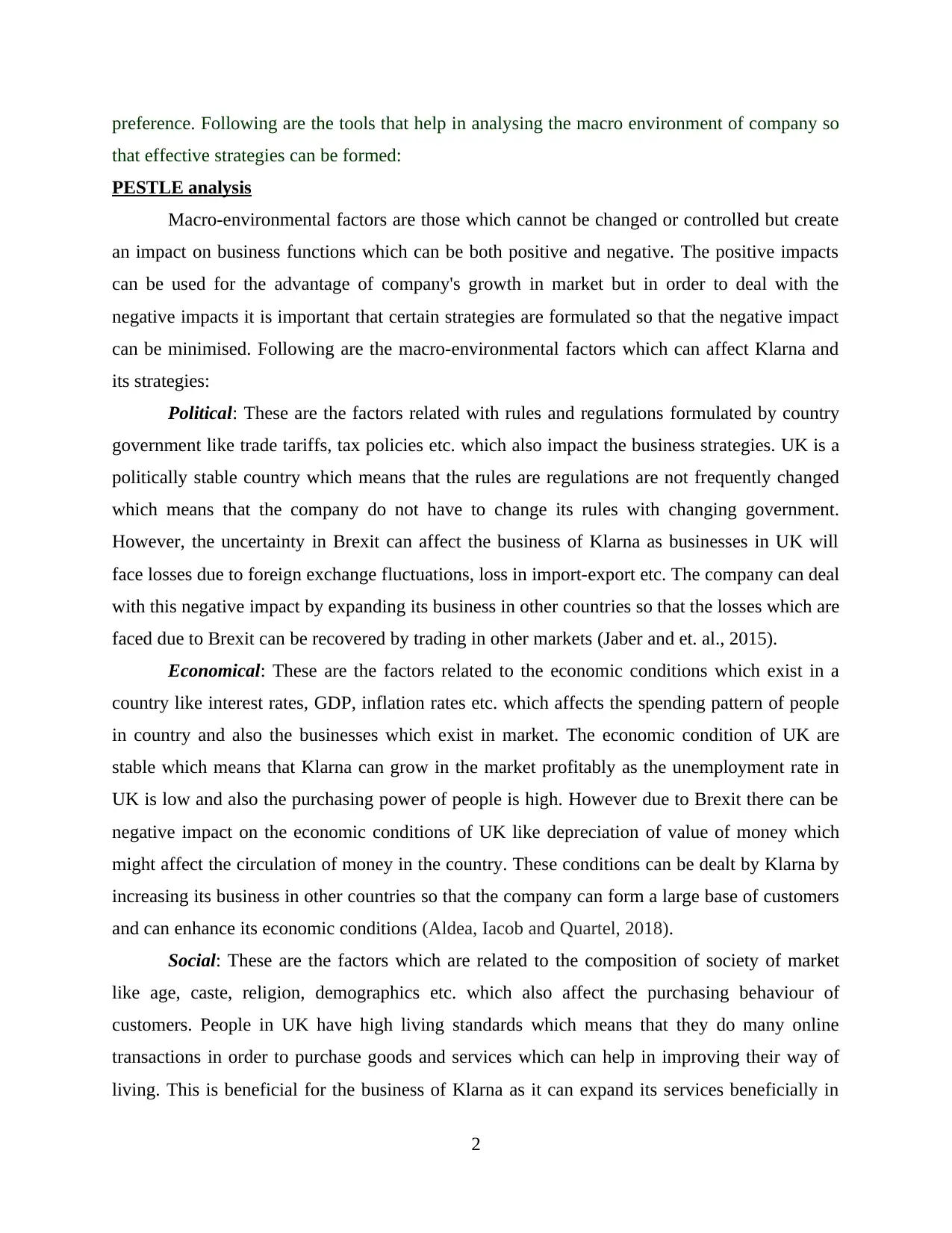
preference. Following are the tools that help in analysing the macro environment of company so
that effective strategies can be formed:
PESTLE analysis
Macro-environmental factors are those which cannot be changed or controlled but create
an impact on business functions which can be both positive and negative. The positive impacts
can be used for the advantage of company's growth in market but in order to deal with the
negative impacts it is important that certain strategies are formulated so that the negative impact
can be minimised. Following are the macro-environmental factors which can affect Klarna and
its strategies:
Political: These are the factors related with rules and regulations formulated by country
government like trade tariffs, tax policies etc. which also impact the business strategies. UK is a
politically stable country which means that the rules are regulations are not frequently changed
which means that the company do not have to change its rules with changing government.
However, the uncertainty in Brexit can affect the business of Klarna as businesses in UK will
face losses due to foreign exchange fluctuations, loss in import-export etc. The company can deal
with this negative impact by expanding its business in other countries so that the losses which are
faced due to Brexit can be recovered by trading in other markets (Jaber and et. al., 2015).
Economical: These are the factors related to the economic conditions which exist in a
country like interest rates, GDP, inflation rates etc. which affects the spending pattern of people
in country and also the businesses which exist in market. The economic condition of UK are
stable which means that Klarna can grow in the market profitably as the unemployment rate in
UK is low and also the purchasing power of people is high. However due to Brexit there can be
negative impact on the economic conditions of UK like depreciation of value of money which
might affect the circulation of money in the country. These conditions can be dealt by Klarna by
increasing its business in other countries so that the company can form a large base of customers
and can enhance its economic conditions (Aldea, Iacob and Quartel, 2018).
Social: These are the factors which are related to the composition of society of market
like age, caste, religion, demographics etc. which also affect the purchasing behaviour of
customers. People in UK have high living standards which means that they do many online
transactions in order to purchase goods and services which can help in improving their way of
living. This is beneficial for the business of Klarna as it can expand its services beneficially in
2
that effective strategies can be formed:
PESTLE analysis
Macro-environmental factors are those which cannot be changed or controlled but create
an impact on business functions which can be both positive and negative. The positive impacts
can be used for the advantage of company's growth in market but in order to deal with the
negative impacts it is important that certain strategies are formulated so that the negative impact
can be minimised. Following are the macro-environmental factors which can affect Klarna and
its strategies:
Political: These are the factors related with rules and regulations formulated by country
government like trade tariffs, tax policies etc. which also impact the business strategies. UK is a
politically stable country which means that the rules are regulations are not frequently changed
which means that the company do not have to change its rules with changing government.
However, the uncertainty in Brexit can affect the business of Klarna as businesses in UK will
face losses due to foreign exchange fluctuations, loss in import-export etc. The company can deal
with this negative impact by expanding its business in other countries so that the losses which are
faced due to Brexit can be recovered by trading in other markets (Jaber and et. al., 2015).
Economical: These are the factors related to the economic conditions which exist in a
country like interest rates, GDP, inflation rates etc. which affects the spending pattern of people
in country and also the businesses which exist in market. The economic condition of UK are
stable which means that Klarna can grow in the market profitably as the unemployment rate in
UK is low and also the purchasing power of people is high. However due to Brexit there can be
negative impact on the economic conditions of UK like depreciation of value of money which
might affect the circulation of money in the country. These conditions can be dealt by Klarna by
increasing its business in other countries so that the company can form a large base of customers
and can enhance its economic conditions (Aldea, Iacob and Quartel, 2018).
Social: These are the factors which are related to the composition of society of market
like age, caste, religion, demographics etc. which also affect the purchasing behaviour of
customers. People in UK have high living standards which means that they do many online
transactions in order to purchase goods and services which can help in improving their way of
living. This is beneficial for the business of Klarna as it can expand its services beneficially in
2
Paraphrase This Document
Need a fresh take? Get an instant paraphrase of this document with our AI Paraphraser
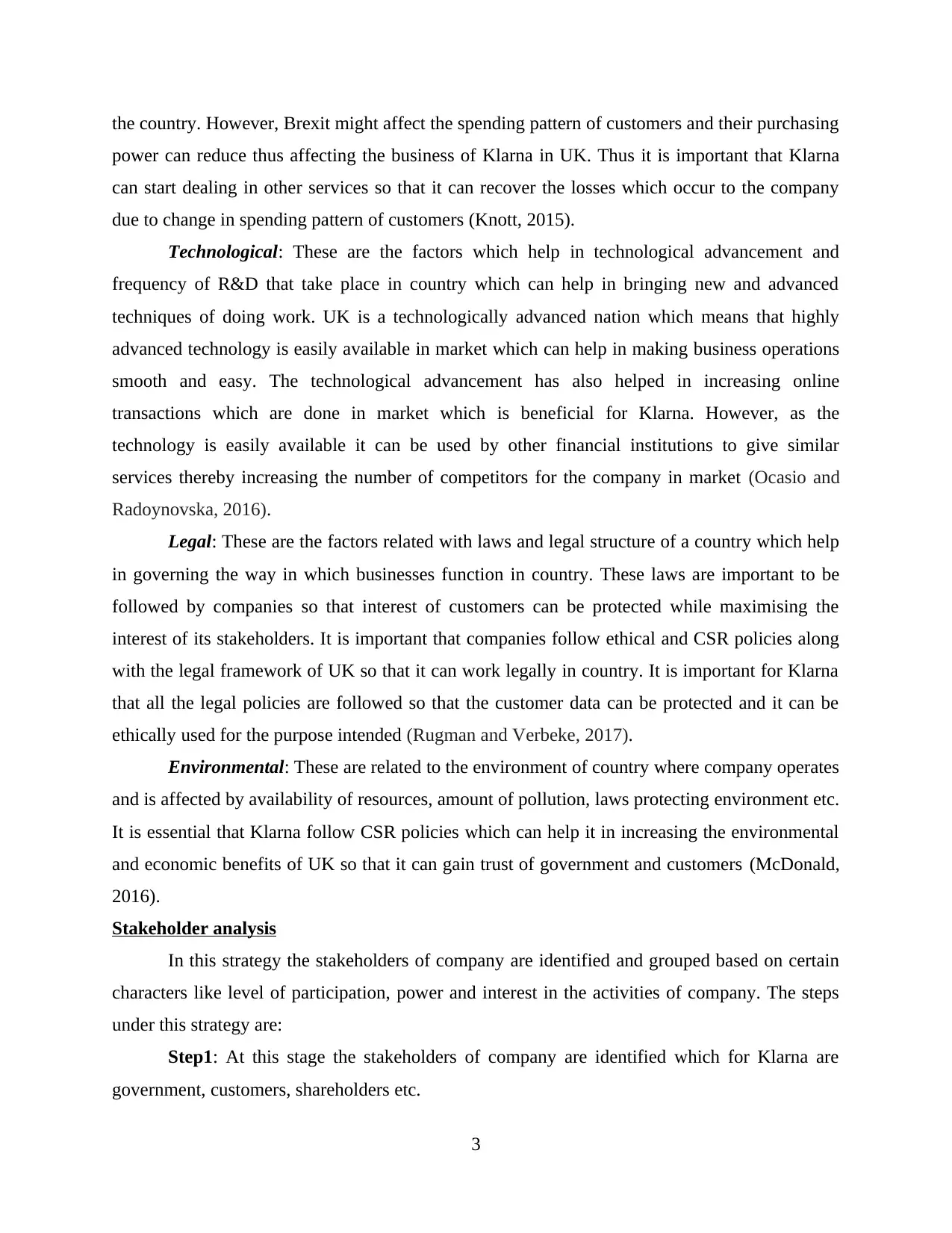
the country. However, Brexit might affect the spending pattern of customers and their purchasing
power can reduce thus affecting the business of Klarna in UK. Thus it is important that Klarna
can start dealing in other services so that it can recover the losses which occur to the company
due to change in spending pattern of customers (Knott, 2015).
Technological: These are the factors which help in technological advancement and
frequency of R&D that take place in country which can help in bringing new and advanced
techniques of doing work. UK is a technologically advanced nation which means that highly
advanced technology is easily available in market which can help in making business operations
smooth and easy. The technological advancement has also helped in increasing online
transactions which are done in market which is beneficial for Klarna. However, as the
technology is easily available it can be used by other financial institutions to give similar
services thereby increasing the number of competitors for the company in market (Ocasio and
Radoynovska, 2016).
Legal: These are the factors related with laws and legal structure of a country which help
in governing the way in which businesses function in country. These laws are important to be
followed by companies so that interest of customers can be protected while maximising the
interest of its stakeholders. It is important that companies follow ethical and CSR policies along
with the legal framework of UK so that it can work legally in country. It is important for Klarna
that all the legal policies are followed so that the customer data can be protected and it can be
ethically used for the purpose intended (Rugman and Verbeke, 2017).
Environmental: These are related to the environment of country where company operates
and is affected by availability of resources, amount of pollution, laws protecting environment etc.
It is essential that Klarna follow CSR policies which can help it in increasing the environmental
and economic benefits of UK so that it can gain trust of government and customers (McDonald,
2016).
Stakeholder analysis
In this strategy the stakeholders of company are identified and grouped based on certain
characters like level of participation, power and interest in the activities of company. The steps
under this strategy are:
Step1: At this stage the stakeholders of company are identified which for Klarna are
government, customers, shareholders etc.
3
power can reduce thus affecting the business of Klarna in UK. Thus it is important that Klarna
can start dealing in other services so that it can recover the losses which occur to the company
due to change in spending pattern of customers (Knott, 2015).
Technological: These are the factors which help in technological advancement and
frequency of R&D that take place in country which can help in bringing new and advanced
techniques of doing work. UK is a technologically advanced nation which means that highly
advanced technology is easily available in market which can help in making business operations
smooth and easy. The technological advancement has also helped in increasing online
transactions which are done in market which is beneficial for Klarna. However, as the
technology is easily available it can be used by other financial institutions to give similar
services thereby increasing the number of competitors for the company in market (Ocasio and
Radoynovska, 2016).
Legal: These are the factors related with laws and legal structure of a country which help
in governing the way in which businesses function in country. These laws are important to be
followed by companies so that interest of customers can be protected while maximising the
interest of its stakeholders. It is important that companies follow ethical and CSR policies along
with the legal framework of UK so that it can work legally in country. It is important for Klarna
that all the legal policies are followed so that the customer data can be protected and it can be
ethically used for the purpose intended (Rugman and Verbeke, 2017).
Environmental: These are related to the environment of country where company operates
and is affected by availability of resources, amount of pollution, laws protecting environment etc.
It is essential that Klarna follow CSR policies which can help it in increasing the environmental
and economic benefits of UK so that it can gain trust of government and customers (McDonald,
2016).
Stakeholder analysis
In this strategy the stakeholders of company are identified and grouped based on certain
characters like level of participation, power and interest in the activities of company. The steps
under this strategy are:
Step1: At this stage the stakeholders of company are identified which for Klarna are
government, customers, shareholders etc.
3
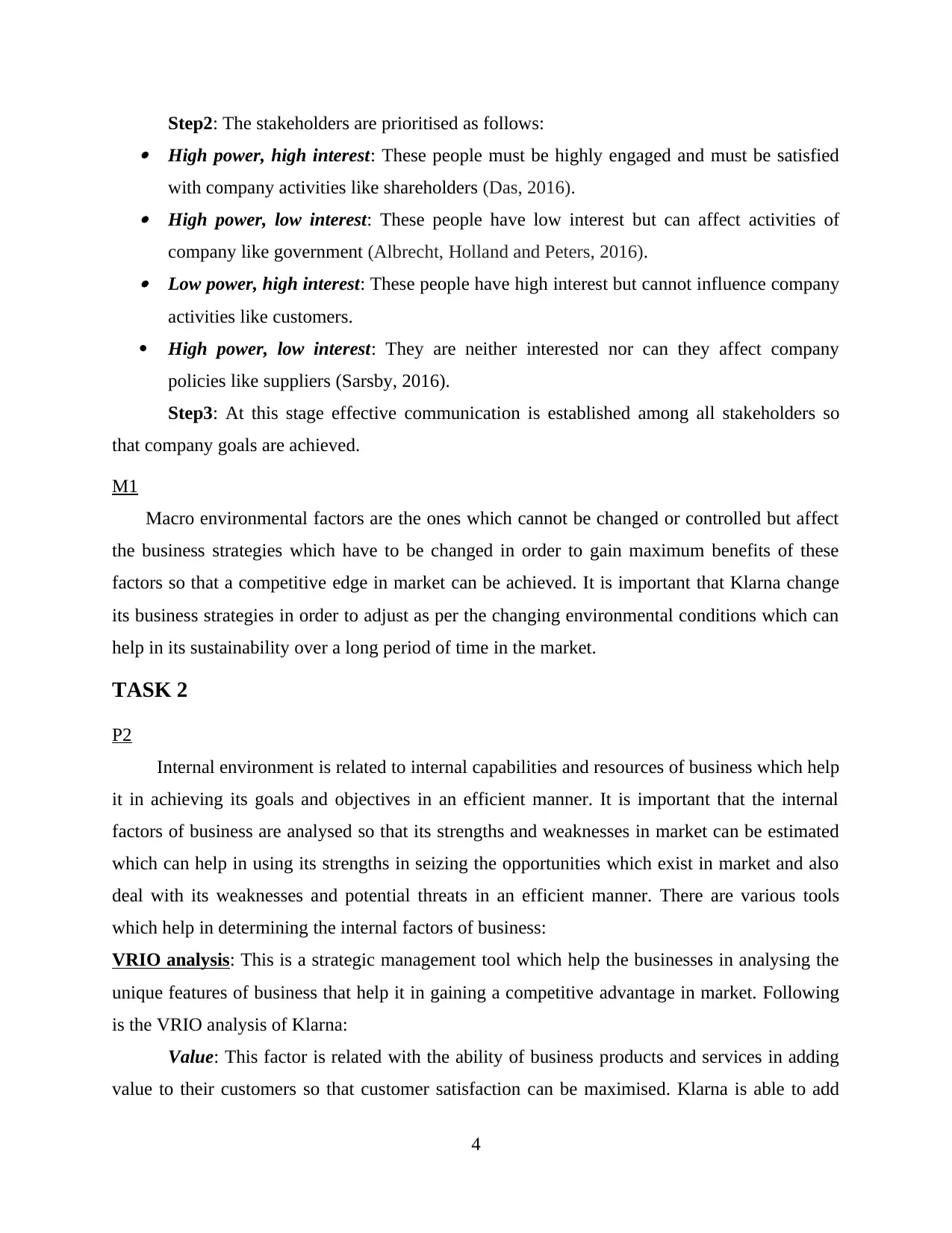
Step2: The stakeholders are prioritised as follows: High power, high interest: These people must be highly engaged and must be satisfied
with company activities like shareholders (Das, 2016). High power, low interest: These people have low interest but can affect activities of
company like government (Albrecht, Holland and Peters, 2016). Low power, high interest: These people have high interest but cannot influence company
activities like customers.
High power, low interest: They are neither interested nor can they affect company
policies like suppliers (Sarsby, 2016).
Step3: At this stage effective communication is established among all stakeholders so
that company goals are achieved.
M1
Macro environmental factors are the ones which cannot be changed or controlled but affect
the business strategies which have to be changed in order to gain maximum benefits of these
factors so that a competitive edge in market can be achieved. It is important that Klarna change
its business strategies in order to adjust as per the changing environmental conditions which can
help in its sustainability over a long period of time in the market.
TASK 2
P2
Internal environment is related to internal capabilities and resources of business which help
it in achieving its goals and objectives in an efficient manner. It is important that the internal
factors of business are analysed so that its strengths and weaknesses in market can be estimated
which can help in using its strengths in seizing the opportunities which exist in market and also
deal with its weaknesses and potential threats in an efficient manner. There are various tools
which help in determining the internal factors of business:
VRIO analysis: This is a strategic management tool which help the businesses in analysing the
unique features of business that help it in gaining a competitive advantage in market. Following
is the VRIO analysis of Klarna:
Value: This factor is related with the ability of business products and services in adding
value to their customers so that customer satisfaction can be maximised. Klarna is able to add
4
with company activities like shareholders (Das, 2016). High power, low interest: These people have low interest but can affect activities of
company like government (Albrecht, Holland and Peters, 2016). Low power, high interest: These people have high interest but cannot influence company
activities like customers.
High power, low interest: They are neither interested nor can they affect company
policies like suppliers (Sarsby, 2016).
Step3: At this stage effective communication is established among all stakeholders so
that company goals are achieved.
M1
Macro environmental factors are the ones which cannot be changed or controlled but affect
the business strategies which have to be changed in order to gain maximum benefits of these
factors so that a competitive edge in market can be achieved. It is important that Klarna change
its business strategies in order to adjust as per the changing environmental conditions which can
help in its sustainability over a long period of time in the market.
TASK 2
P2
Internal environment is related to internal capabilities and resources of business which help
it in achieving its goals and objectives in an efficient manner. It is important that the internal
factors of business are analysed so that its strengths and weaknesses in market can be estimated
which can help in using its strengths in seizing the opportunities which exist in market and also
deal with its weaknesses and potential threats in an efficient manner. There are various tools
which help in determining the internal factors of business:
VRIO analysis: This is a strategic management tool which help the businesses in analysing the
unique features of business that help it in gaining a competitive advantage in market. Following
is the VRIO analysis of Klarna:
Value: This factor is related with the ability of business products and services in adding
value to their customers so that customer satisfaction can be maximised. Klarna is able to add
4
⊘ This is a preview!⊘
Do you want full access?
Subscribe today to unlock all pages.

Trusted by 1+ million students worldwide
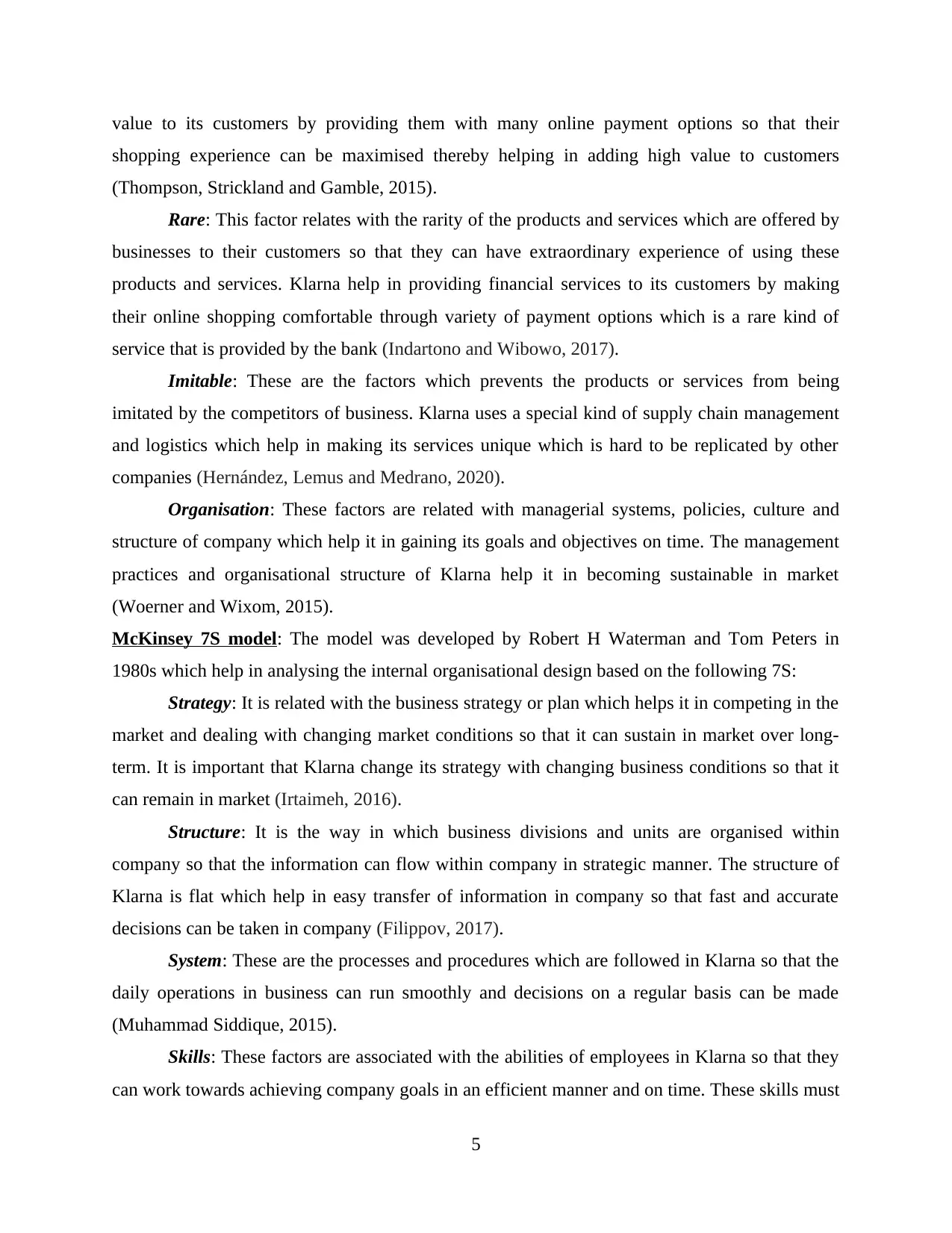
value to its customers by providing them with many online payment options so that their
shopping experience can be maximised thereby helping in adding high value to customers
(Thompson, Strickland and Gamble, 2015).
Rare: This factor relates with the rarity of the products and services which are offered by
businesses to their customers so that they can have extraordinary experience of using these
products and services. Klarna help in providing financial services to its customers by making
their online shopping comfortable through variety of payment options which is a rare kind of
service that is provided by the bank (Indartono and Wibowo, 2017).
Imitable: These are the factors which prevents the products or services from being
imitated by the competitors of business. Klarna uses a special kind of supply chain management
and logistics which help in making its services unique which is hard to be replicated by other
companies (Hernández, Lemus and Medrano, 2020).
Organisation: These factors are related with managerial systems, policies, culture and
structure of company which help it in gaining its goals and objectives on time. The management
practices and organisational structure of Klarna help it in becoming sustainable in market
(Woerner and Wixom, 2015).
McKinsey 7S model: The model was developed by Robert H Waterman and Tom Peters in
1980s which help in analysing the internal organisational design based on the following 7S:
Strategy: It is related with the business strategy or plan which helps it in competing in the
market and dealing with changing market conditions so that it can sustain in market over long-
term. It is important that Klarna change its strategy with changing business conditions so that it
can remain in market (Irtaimeh, 2016).
Structure: It is the way in which business divisions and units are organised within
company so that the information can flow within company in strategic manner. The structure of
Klarna is flat which help in easy transfer of information in company so that fast and accurate
decisions can be taken in company (Filippov, 2017).
System: These are the processes and procedures which are followed in Klarna so that the
daily operations in business can run smoothly and decisions on a regular basis can be made
(Muhammad Siddique, 2015).
Skills: These factors are associated with the abilities of employees in Klarna so that they
can work towards achieving company goals in an efficient manner and on time. These skills must
5
shopping experience can be maximised thereby helping in adding high value to customers
(Thompson, Strickland and Gamble, 2015).
Rare: This factor relates with the rarity of the products and services which are offered by
businesses to their customers so that they can have extraordinary experience of using these
products and services. Klarna help in providing financial services to its customers by making
their online shopping comfortable through variety of payment options which is a rare kind of
service that is provided by the bank (Indartono and Wibowo, 2017).
Imitable: These are the factors which prevents the products or services from being
imitated by the competitors of business. Klarna uses a special kind of supply chain management
and logistics which help in making its services unique which is hard to be replicated by other
companies (Hernández, Lemus and Medrano, 2020).
Organisation: These factors are related with managerial systems, policies, culture and
structure of company which help it in gaining its goals and objectives on time. The management
practices and organisational structure of Klarna help it in becoming sustainable in market
(Woerner and Wixom, 2015).
McKinsey 7S model: The model was developed by Robert H Waterman and Tom Peters in
1980s which help in analysing the internal organisational design based on the following 7S:
Strategy: It is related with the business strategy or plan which helps it in competing in the
market and dealing with changing market conditions so that it can sustain in market over long-
term. It is important that Klarna change its strategy with changing business conditions so that it
can remain in market (Irtaimeh, 2016).
Structure: It is the way in which business divisions and units are organised within
company so that the information can flow within company in strategic manner. The structure of
Klarna is flat which help in easy transfer of information in company so that fast and accurate
decisions can be taken in company (Filippov, 2017).
System: These are the processes and procedures which are followed in Klarna so that the
daily operations in business can run smoothly and decisions on a regular basis can be made
(Muhammad Siddique, 2015).
Skills: These factors are associated with the abilities of employees in Klarna so that they
can work towards achieving company goals in an efficient manner and on time. These skills must
5
Paraphrase This Document
Need a fresh take? Get an instant paraphrase of this document with our AI Paraphraser
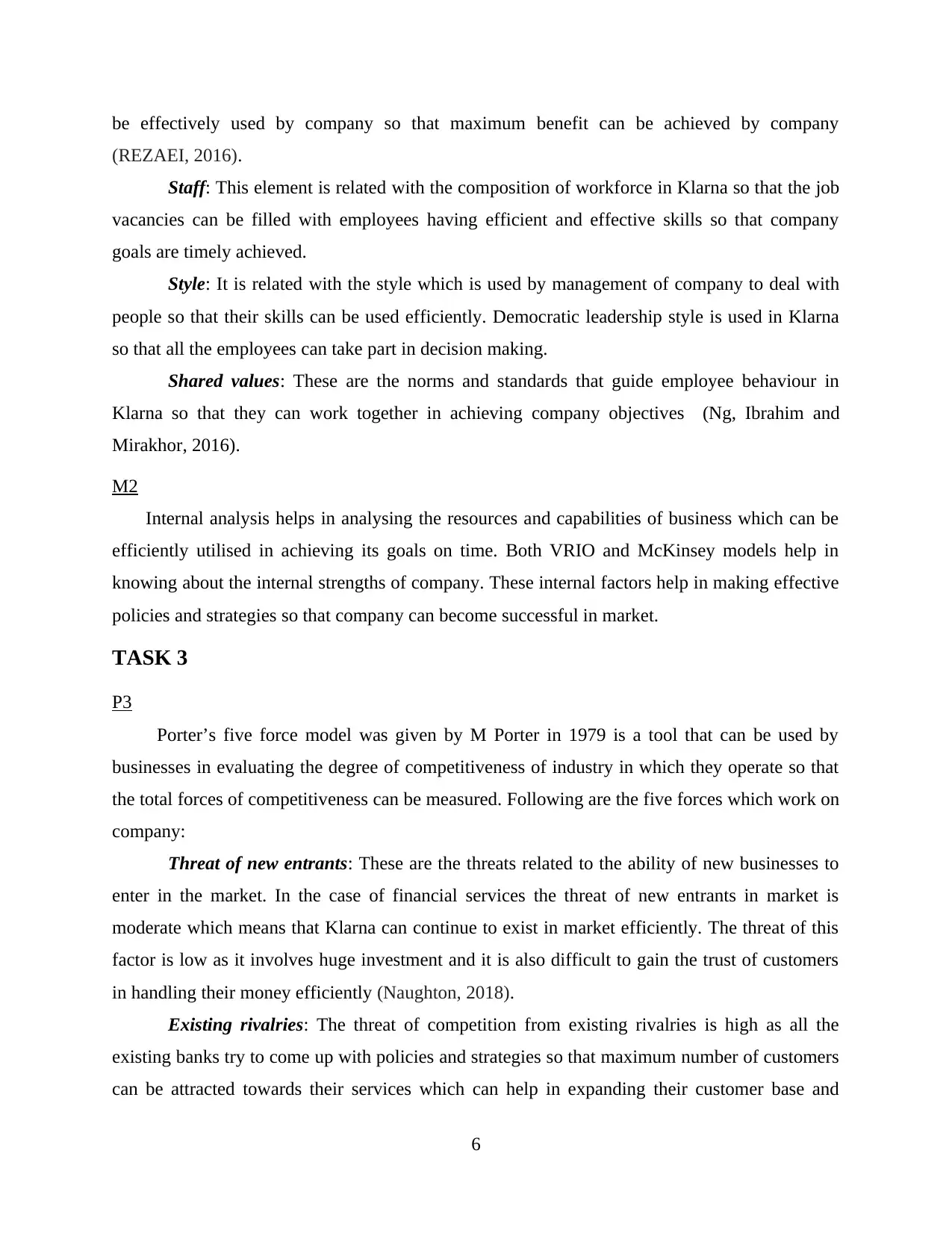
be effectively used by company so that maximum benefit can be achieved by company
(REZAEI, 2016).
Staff: This element is related with the composition of workforce in Klarna so that the job
vacancies can be filled with employees having efficient and effective skills so that company
goals are timely achieved.
Style: It is related with the style which is used by management of company to deal with
people so that their skills can be used efficiently. Democratic leadership style is used in Klarna
so that all the employees can take part in decision making.
Shared values: These are the norms and standards that guide employee behaviour in
Klarna so that they can work together in achieving company objectives (Ng, Ibrahim and
Mirakhor, 2016).
M2
Internal analysis helps in analysing the resources and capabilities of business which can be
efficiently utilised in achieving its goals on time. Both VRIO and McKinsey models help in
knowing about the internal strengths of company. These internal factors help in making effective
policies and strategies so that company can become successful in market.
TASK 3
P3
Porter’s five force model was given by M Porter in 1979 is a tool that can be used by
businesses in evaluating the degree of competitiveness of industry in which they operate so that
the total forces of competitiveness can be measured. Following are the five forces which work on
company:
Threat of new entrants: These are the threats related to the ability of new businesses to
enter in the market. In the case of financial services the threat of new entrants in market is
moderate which means that Klarna can continue to exist in market efficiently. The threat of this
factor is low as it involves huge investment and it is also difficult to gain the trust of customers
in handling their money efficiently (Naughton, 2018).
Existing rivalries: The threat of competition from existing rivalries is high as all the
existing banks try to come up with policies and strategies so that maximum number of customers
can be attracted towards their services which can help in expanding their customer base and
6
(REZAEI, 2016).
Staff: This element is related with the composition of workforce in Klarna so that the job
vacancies can be filled with employees having efficient and effective skills so that company
goals are timely achieved.
Style: It is related with the style which is used by management of company to deal with
people so that their skills can be used efficiently. Democratic leadership style is used in Klarna
so that all the employees can take part in decision making.
Shared values: These are the norms and standards that guide employee behaviour in
Klarna so that they can work together in achieving company objectives (Ng, Ibrahim and
Mirakhor, 2016).
M2
Internal analysis helps in analysing the resources and capabilities of business which can be
efficiently utilised in achieving its goals on time. Both VRIO and McKinsey models help in
knowing about the internal strengths of company. These internal factors help in making effective
policies and strategies so that company can become successful in market.
TASK 3
P3
Porter’s five force model was given by M Porter in 1979 is a tool that can be used by
businesses in evaluating the degree of competitiveness of industry in which they operate so that
the total forces of competitiveness can be measured. Following are the five forces which work on
company:
Threat of new entrants: These are the threats related to the ability of new businesses to
enter in the market. In the case of financial services the threat of new entrants in market is
moderate which means that Klarna can continue to exist in market efficiently. The threat of this
factor is low as it involves huge investment and it is also difficult to gain the trust of customers
in handling their money efficiently (Naughton, 2018).
Existing rivalries: The threat of competition from existing rivalries is high as all the
existing banks try to come up with policies and strategies so that maximum number of customers
can be attracted towards their services which can help in expanding their customer base and
6
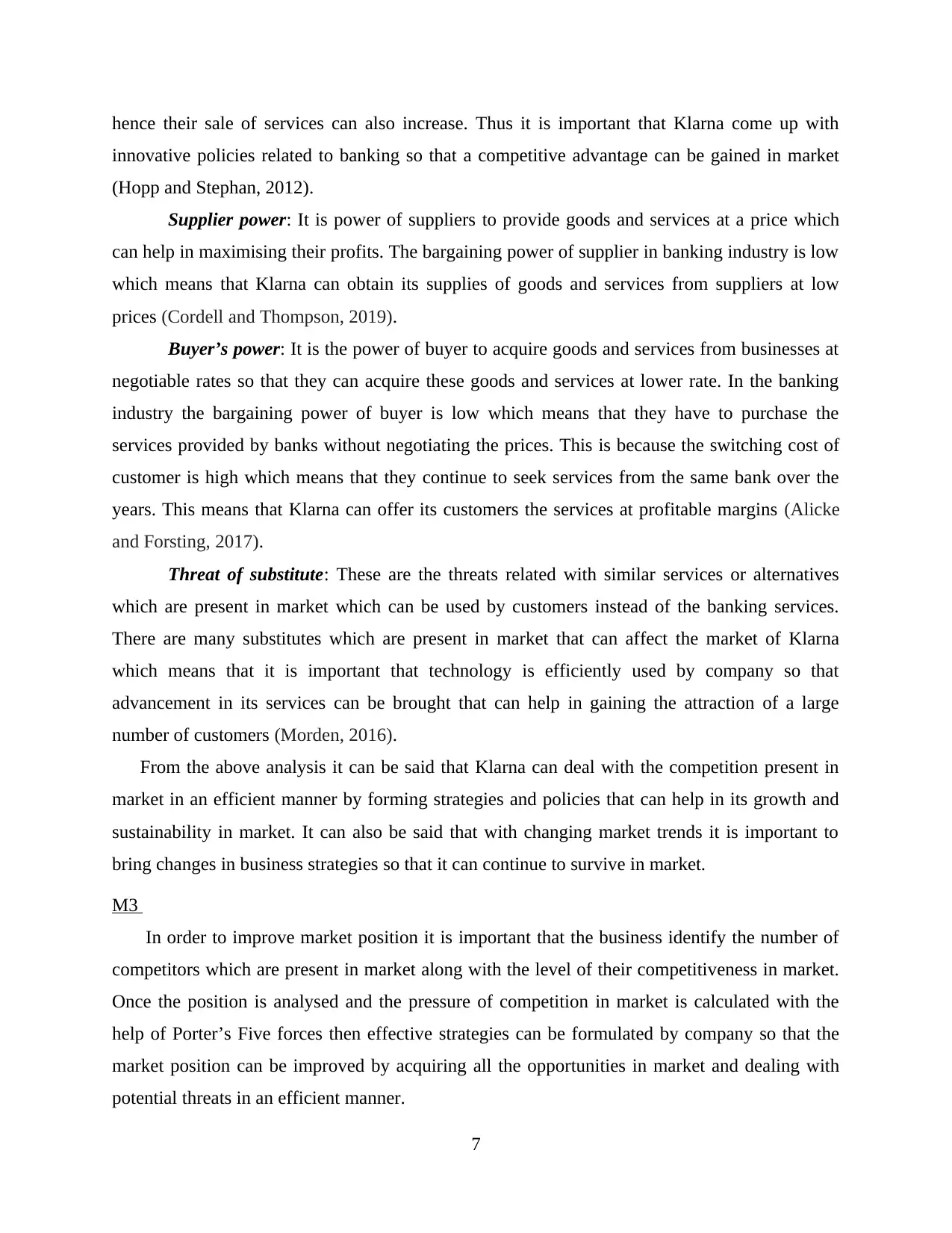
hence their sale of services can also increase. Thus it is important that Klarna come up with
innovative policies related to banking so that a competitive advantage can be gained in market
(Hopp and Stephan, 2012).
Supplier power: It is power of suppliers to provide goods and services at a price which
can help in maximising their profits. The bargaining power of supplier in banking industry is low
which means that Klarna can obtain its supplies of goods and services from suppliers at low
prices (Cordell and Thompson, 2019).
Buyer’s power: It is the power of buyer to acquire goods and services from businesses at
negotiable rates so that they can acquire these goods and services at lower rate. In the banking
industry the bargaining power of buyer is low which means that they have to purchase the
services provided by banks without negotiating the prices. This is because the switching cost of
customer is high which means that they continue to seek services from the same bank over the
years. This means that Klarna can offer its customers the services at profitable margins (Alicke
and Forsting, 2017).
Threat of substitute: These are the threats related with similar services or alternatives
which are present in market which can be used by customers instead of the banking services.
There are many substitutes which are present in market that can affect the market of Klarna
which means that it is important that technology is efficiently used by company so that
advancement in its services can be brought that can help in gaining the attraction of a large
number of customers (Morden, 2016).
From the above analysis it can be said that Klarna can deal with the competition present in
market in an efficient manner by forming strategies and policies that can help in its growth and
sustainability in market. It can also be said that with changing market trends it is important to
bring changes in business strategies so that it can continue to survive in market.
M3
In order to improve market position it is important that the business identify the number of
competitors which are present in market along with the level of their competitiveness in market.
Once the position is analysed and the pressure of competition in market is calculated with the
help of Porter’s Five forces then effective strategies can be formulated by company so that the
market position can be improved by acquiring all the opportunities in market and dealing with
potential threats in an efficient manner.
7
innovative policies related to banking so that a competitive advantage can be gained in market
(Hopp and Stephan, 2012).
Supplier power: It is power of suppliers to provide goods and services at a price which
can help in maximising their profits. The bargaining power of supplier in banking industry is low
which means that Klarna can obtain its supplies of goods and services from suppliers at low
prices (Cordell and Thompson, 2019).
Buyer’s power: It is the power of buyer to acquire goods and services from businesses at
negotiable rates so that they can acquire these goods and services at lower rate. In the banking
industry the bargaining power of buyer is low which means that they have to purchase the
services provided by banks without negotiating the prices. This is because the switching cost of
customer is high which means that they continue to seek services from the same bank over the
years. This means that Klarna can offer its customers the services at profitable margins (Alicke
and Forsting, 2017).
Threat of substitute: These are the threats related with similar services or alternatives
which are present in market which can be used by customers instead of the banking services.
There are many substitutes which are present in market that can affect the market of Klarna
which means that it is important that technology is efficiently used by company so that
advancement in its services can be brought that can help in gaining the attraction of a large
number of customers (Morden, 2016).
From the above analysis it can be said that Klarna can deal with the competition present in
market in an efficient manner by forming strategies and policies that can help in its growth and
sustainability in market. It can also be said that with changing market trends it is important to
bring changes in business strategies so that it can continue to survive in market.
M3
In order to improve market position it is important that the business identify the number of
competitors which are present in market along with the level of their competitiveness in market.
Once the position is analysed and the pressure of competition in market is calculated with the
help of Porter’s Five forces then effective strategies can be formulated by company so that the
market position can be improved by acquiring all the opportunities in market and dealing with
potential threats in an efficient manner.
7
⊘ This is a preview!⊘
Do you want full access?
Subscribe today to unlock all pages.

Trusted by 1+ million students worldwide
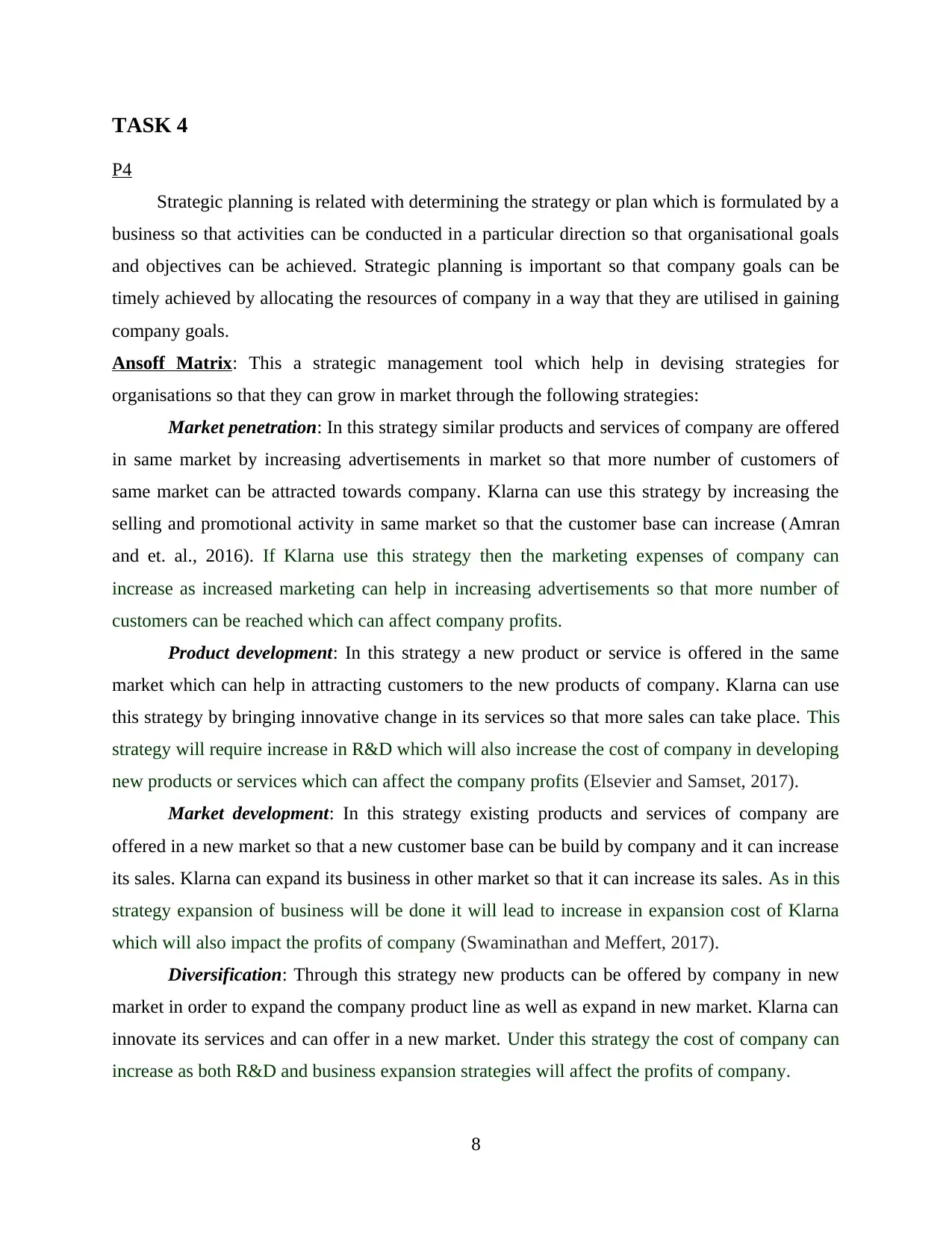
TASK 4
P4
Strategic planning is related with determining the strategy or plan which is formulated by a
business so that activities can be conducted in a particular direction so that organisational goals
and objectives can be achieved. Strategic planning is important so that company goals can be
timely achieved by allocating the resources of company in a way that they are utilised in gaining
company goals.
Ansoff Matrix: This a strategic management tool which help in devising strategies for
organisations so that they can grow in market through the following strategies:
Market penetration: In this strategy similar products and services of company are offered
in same market by increasing advertisements in market so that more number of customers of
same market can be attracted towards company. Klarna can use this strategy by increasing the
selling and promotional activity in same market so that the customer base can increase (Amran
and et. al., 2016). If Klarna use this strategy then the marketing expenses of company can
increase as increased marketing can help in increasing advertisements so that more number of
customers can be reached which can affect company profits.
Product development: In this strategy a new product or service is offered in the same
market which can help in attracting customers to the new products of company. Klarna can use
this strategy by bringing innovative change in its services so that more sales can take place. This
strategy will require increase in R&D which will also increase the cost of company in developing
new products or services which can affect the company profits (Elsevier and Samset, 2017).
Market development: In this strategy existing products and services of company are
offered in a new market so that a new customer base can be build by company and it can increase
its sales. Klarna can expand its business in other market so that it can increase its sales. As in this
strategy expansion of business will be done it will lead to increase in expansion cost of Klarna
which will also impact the profits of company (Swaminathan and Meffert, 2017).
Diversification: Through this strategy new products can be offered by company in new
market in order to expand the company product line as well as expand in new market. Klarna can
innovate its services and can offer in a new market. Under this strategy the cost of company can
increase as both R&D and business expansion strategies will affect the profits of company.
8
P4
Strategic planning is related with determining the strategy or plan which is formulated by a
business so that activities can be conducted in a particular direction so that organisational goals
and objectives can be achieved. Strategic planning is important so that company goals can be
timely achieved by allocating the resources of company in a way that they are utilised in gaining
company goals.
Ansoff Matrix: This a strategic management tool which help in devising strategies for
organisations so that they can grow in market through the following strategies:
Market penetration: In this strategy similar products and services of company are offered
in same market by increasing advertisements in market so that more number of customers of
same market can be attracted towards company. Klarna can use this strategy by increasing the
selling and promotional activity in same market so that the customer base can increase (Amran
and et. al., 2016). If Klarna use this strategy then the marketing expenses of company can
increase as increased marketing can help in increasing advertisements so that more number of
customers can be reached which can affect company profits.
Product development: In this strategy a new product or service is offered in the same
market which can help in attracting customers to the new products of company. Klarna can use
this strategy by bringing innovative change in its services so that more sales can take place. This
strategy will require increase in R&D which will also increase the cost of company in developing
new products or services which can affect the company profits (Elsevier and Samset, 2017).
Market development: In this strategy existing products and services of company are
offered in a new market so that a new customer base can be build by company and it can increase
its sales. Klarna can expand its business in other market so that it can increase its sales. As in this
strategy expansion of business will be done it will lead to increase in expansion cost of Klarna
which will also impact the profits of company (Swaminathan and Meffert, 2017).
Diversification: Through this strategy new products can be offered by company in new
market in order to expand the company product line as well as expand in new market. Klarna can
innovate its services and can offer in a new market. Under this strategy the cost of company can
increase as both R&D and business expansion strategies will affect the profits of company.
8
Paraphrase This Document
Need a fresh take? Get an instant paraphrase of this document with our AI Paraphraser
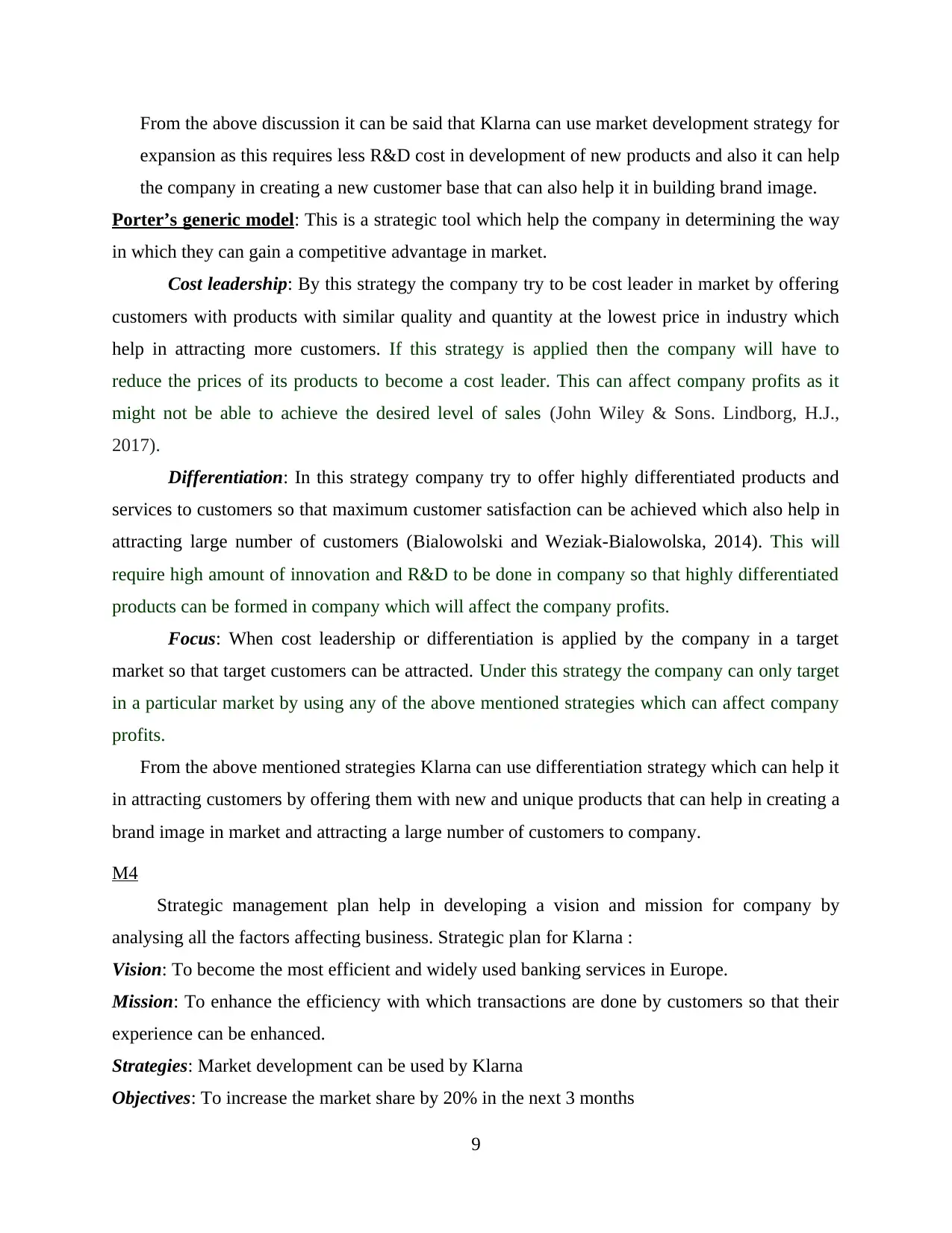
From the above discussion it can be said that Klarna can use market development strategy for
expansion as this requires less R&D cost in development of new products and also it can help
the company in creating a new customer base that can also help it in building brand image.
Porter’s generic model: This is a strategic tool which help the company in determining the way
in which they can gain a competitive advantage in market.
Cost leadership: By this strategy the company try to be cost leader in market by offering
customers with products with similar quality and quantity at the lowest price in industry which
help in attracting more customers. If this strategy is applied then the company will have to
reduce the prices of its products to become a cost leader. This can affect company profits as it
might not be able to achieve the desired level of sales (John Wiley & Sons. Lindborg, H.J.,
2017).
Differentiation: In this strategy company try to offer highly differentiated products and
services to customers so that maximum customer satisfaction can be achieved which also help in
attracting large number of customers (Bialowolski and Weziak-Bialowolska, 2014). This will
require high amount of innovation and R&D to be done in company so that highly differentiated
products can be formed in company which will affect the company profits.
Focus: When cost leadership or differentiation is applied by the company in a target
market so that target customers can be attracted. Under this strategy the company can only target
in a particular market by using any of the above mentioned strategies which can affect company
profits.
From the above mentioned strategies Klarna can use differentiation strategy which can help it
in attracting customers by offering them with new and unique products that can help in creating a
brand image in market and attracting a large number of customers to company.
M4
Strategic management plan help in developing a vision and mission for company by
analysing all the factors affecting business. Strategic plan for Klarna :
Vision: To become the most efficient and widely used banking services in Europe.
Mission: To enhance the efficiency with which transactions are done by customers so that their
experience can be enhanced.
Strategies: Market development can be used by Klarna
Objectives: To increase the market share by 20% in the next 3 months
9
expansion as this requires less R&D cost in development of new products and also it can help
the company in creating a new customer base that can also help it in building brand image.
Porter’s generic model: This is a strategic tool which help the company in determining the way
in which they can gain a competitive advantage in market.
Cost leadership: By this strategy the company try to be cost leader in market by offering
customers with products with similar quality and quantity at the lowest price in industry which
help in attracting more customers. If this strategy is applied then the company will have to
reduce the prices of its products to become a cost leader. This can affect company profits as it
might not be able to achieve the desired level of sales (John Wiley & Sons. Lindborg, H.J.,
2017).
Differentiation: In this strategy company try to offer highly differentiated products and
services to customers so that maximum customer satisfaction can be achieved which also help in
attracting large number of customers (Bialowolski and Weziak-Bialowolska, 2014). This will
require high amount of innovation and R&D to be done in company so that highly differentiated
products can be formed in company which will affect the company profits.
Focus: When cost leadership or differentiation is applied by the company in a target
market so that target customers can be attracted. Under this strategy the company can only target
in a particular market by using any of the above mentioned strategies which can affect company
profits.
From the above mentioned strategies Klarna can use differentiation strategy which can help it
in attracting customers by offering them with new and unique products that can help in creating a
brand image in market and attracting a large number of customers to company.
M4
Strategic management plan help in developing a vision and mission for company by
analysing all the factors affecting business. Strategic plan for Klarna :
Vision: To become the most efficient and widely used banking services in Europe.
Mission: To enhance the efficiency with which transactions are done by customers so that their
experience can be enhanced.
Strategies: Market development can be used by Klarna
Objectives: To increase the market share by 20% in the next 3 months
9
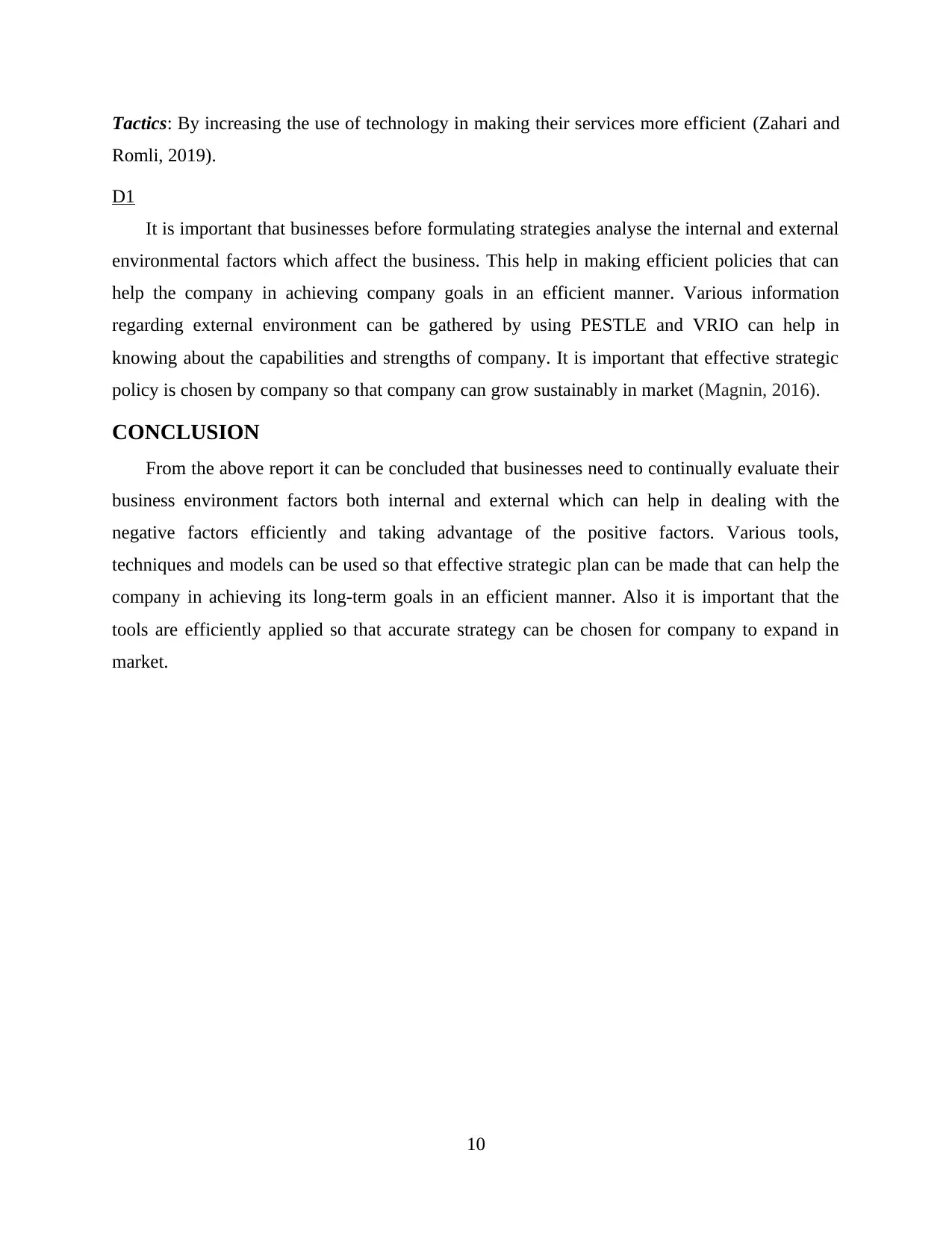
Tactics: By increasing the use of technology in making their services more efficient (Zahari and
Romli, 2019).
D1
It is important that businesses before formulating strategies analyse the internal and external
environmental factors which affect the business. This help in making efficient policies that can
help the company in achieving company goals in an efficient manner. Various information
regarding external environment can be gathered by using PESTLE and VRIO can help in
knowing about the capabilities and strengths of company. It is important that effective strategic
policy is chosen by company so that company can grow sustainably in market (Magnin, 2016).
CONCLUSION
From the above report it can be concluded that businesses need to continually evaluate their
business environment factors both internal and external which can help in dealing with the
negative factors efficiently and taking advantage of the positive factors. Various tools,
techniques and models can be used so that effective strategic plan can be made that can help the
company in achieving its long-term goals in an efficient manner. Also it is important that the
tools are efficiently applied so that accurate strategy can be chosen for company to expand in
market.
10
Romli, 2019).
D1
It is important that businesses before formulating strategies analyse the internal and external
environmental factors which affect the business. This help in making efficient policies that can
help the company in achieving company goals in an efficient manner. Various information
regarding external environment can be gathered by using PESTLE and VRIO can help in
knowing about the capabilities and strengths of company. It is important that effective strategic
policy is chosen by company so that company can grow sustainably in market (Magnin, 2016).
CONCLUSION
From the above report it can be concluded that businesses need to continually evaluate their
business environment factors both internal and external which can help in dealing with the
negative factors efficiently and taking advantage of the positive factors. Various tools,
techniques and models can be used so that effective strategic plan can be made that can help the
company in achieving its long-term goals in an efficient manner. Also it is important that the
tools are efficiently applied so that accurate strategy can be chosen for company to expand in
market.
10
⊘ This is a preview!⊘
Do you want full access?
Subscribe today to unlock all pages.

Trusted by 1+ million students worldwide
1 out of 14
Related Documents
Your All-in-One AI-Powered Toolkit for Academic Success.
+13062052269
info@desklib.com
Available 24*7 on WhatsApp / Email
![[object Object]](/_next/static/media/star-bottom.7253800d.svg)
Unlock your academic potential
Copyright © 2020–2025 A2Z Services. All Rights Reserved. Developed and managed by ZUCOL.





